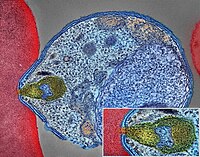
Photo from wikipedia
Abstract Climatic incompatibility between source and intended release sites of biological control agents is frequently cited as a limiting factor to their establishment and proliferation, and ultimately the successful control… Click to show full abstract
Abstract Climatic incompatibility between source and intended release sites of biological control agents is frequently cited as a limiting factor to their establishment and proliferation, and ultimately the successful control of a target weed. Climate matching techniques have been used to overcome this limitation by prioritising regions in the target weed’s native range to survey for climatically-matched control agents. However, climate matching has been criticised for not considering that climatically compatible regions may not contain host-plant populations, which is especially important for weeds with an unknown or uncertain native distribution. To overcome this limitation, an ecological niche modelling approach (MaxEnt) was used to identify “sweet-spots” to search for candidate biological control agents for two African grasses that are invasive in Australia, namely: Sporobolus pyramidalis P. Beauv. and S. natalensis (Steud.) Dur. & Schinz (Poaceae) (giant rat’s tail grasses). “Sweet-spots” were identified by overlaying rasters indicative of climatic suitability for plant growth, reproduction and survival (i.e. models calibrated using native range occurrences) and climatic compatibility with intended biological control agent release sites in Australia (i.e. models calibrated using invaded range occurrences). This approach reduced the total geographic search area by 3.8–7.5 million km2 (57–88% of the total search area), with respect to traditional climatic matching techniques. The models identified: eastern South Africa, eastern Madagascar, Ethiopia, Kenya and coastal West Africa (S. pyramidalis only) as high-priority regions to search for potentially climatically-matched biological control agents. These findings are discussed in the context of guiding and optimising the native range component of this biological control programme, and how this increases the likelihood of successfully managing weed infestations in Australia.
Journal Title: Biological Control
Year Published: 2019
Link to full text (if available)
Share on Social Media: Sign Up to like & get
recommendations!